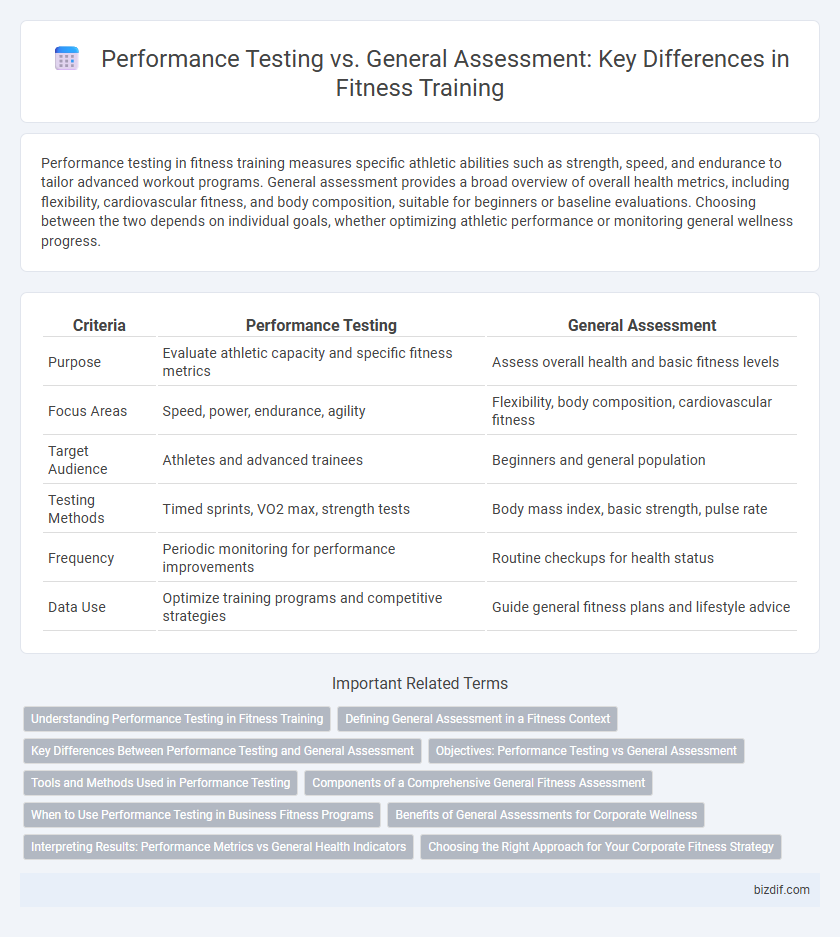Performance testing in fitness training measures specific athletic abilities such as strength, speed, and endurance to tailor advanced workout programs. General assessment provides a broad overview of overall health metrics, including flexibility, cardiovascular fitness, and body composition, suitable for beginners or baseline evaluations. Choosing between the two depends on individual goals, whether optimizing athletic performance or monitoring general wellness progress.
Table of Comparison
| Criteria | Performance Testing | General Assessment |
|---|---|---|
| Purpose | Evaluate athletic capacity and specific fitness metrics | Assess overall health and basic fitness levels |
| Focus Areas | Speed, power, endurance, agility | Flexibility, body composition, cardiovascular fitness |
| Target Audience | Athletes and advanced trainees | Beginners and general population |
| Testing Methods | Timed sprints, VO2 max, strength tests | Body mass index, basic strength, pulse rate |
| Frequency | Periodic monitoring for performance improvements | Routine checkups for health status |
| Data Use | Optimize training programs and competitive strategies | Guide general fitness plans and lifestyle advice |
Understanding Performance Testing in Fitness Training
Performance testing in fitness training measures specific physical abilities such as strength, endurance, power, and agility to tailor training programs effectively. It provides objective data through tests like VO2 max, 1RM (one-repetition maximum), and sprint times, enabling precise tracking of progress and identifying areas for improvement. Unlike general assessment, performance testing focuses on athletic potential and functional capacity, optimizing workout strategies for enhanced results.
Defining General Assessment in a Fitness Context
General assessment in a fitness context involves evaluating an individual's overall physical condition through a variety of standardized tests that measure strength, endurance, flexibility, and cardiovascular health. This type of assessment provides a comprehensive overview of baseline fitness levels, helping to identify strengths, weaknesses, and potential health risks. Unlike performance testing, which targets specific athletic skills, general assessment aims to inform personalized training plans for improved overall well-being.
Key Differences Between Performance Testing and General Assessment
Performance testing measures specific athletic abilities such as strength, speed, agility, and endurance using standardized protocols to identify precise fitness levels and potential improvements. General assessments evaluate overall health and fitness through broader metrics like body composition, cardiovascular health, and flexibility, providing a holistic view of an individual's wellness. Key differences lie in the purpose and specificity, with performance testing targeting sport-specific skills and general assessment focusing on comprehensive health indicators.
Objectives: Performance Testing vs General Assessment
Performance testing aims to measure specific physical capabilities such as strength, speed, and endurance under controlled conditions to track athletic progress and optimize training programs. General assessment evaluates overall health and fitness levels, including body composition, cardiovascular health, and mobility, to establish a baseline for wellness and physical activity recommendations. The objective of performance testing is to enhance sports-specific outcomes, whereas general assessment focuses on broader health improvements and risk identification.
Tools and Methods Used in Performance Testing
Performance testing in fitness training employs specialized tools such as VO2 max analyzers, lactate threshold tests, and force plates to measure an athlete's physiological and biomechanical capabilities precisely. These methods include treadmill or cycle ergometer protocols for cardiovascular endurance, isokinetic dynamometry for muscle strength, and motion capture technology for movement analysis. Unlike general assessments that rely on broad metrics like BMI or body fat percentage, performance testing utilizes targeted data collection to optimize training plans and track progress accurately.
Components of a Comprehensive General Fitness Assessment
Components of a comprehensive general fitness assessment include cardiovascular endurance, muscular strength, muscular endurance, flexibility, and body composition, providing a holistic evaluation of overall health and physical fitness. Performance testing focuses on sport-specific skills and metrics such as speed, agility, power, and sport-specific endurance, targeting improvements in athletic performance. General assessments establish baseline fitness levels and identify areas for improvement by measuring functional capacity across multiple fitness domains.
When to Use Performance Testing in Business Fitness Programs
Performance testing is essential in business fitness programs to measure specific athletic capabilities such as strength, speed, endurance, and agility, providing data-driven insights to tailor training interventions. It is most effective when precise benchmarks are needed to track improvements, set performance goals, or identify potential injury risks in employees or athletes. Businesses should implement performance testing periodically during training cycles to optimize physical conditioning and enhance overall workplace productivity.
Benefits of General Assessments for Corporate Wellness
General assessments in corporate wellness provide a comprehensive overview of employees' overall health, enabling personalized fitness plans that enhance productivity and reduce injury risk. These assessments evaluate multiple fitness components like cardiovascular endurance, flexibility, and body composition, offering actionable insights for holistic health improvements. Incorporating routine general assessments fosters a culture of well-being, leading to increased employee engagement and reduced healthcare costs for companies.
Interpreting Results: Performance Metrics vs General Health Indicators
Performance testing provides specific metrics such as VO2 max, power output, and lactate threshold to evaluate athletic capabilities and guide targeted training programs. General assessments focus on health indicators including blood pressure, BMI, and resting heart rate to monitor overall wellness and disease risk. Interpreting these results requires understanding that performance metrics inform physical optimization, while general health indicators assess baseline fitness and long-term health status.
Choosing the Right Approach for Your Corporate Fitness Strategy
Performance testing measures specific physical abilities such as strength, endurance, and agility to tailor training programs that enhance employee productivity and reduce injury risk. General assessment offers a broad overview of overall health metrics like cardiovascular fitness and body composition, providing baseline data for wellness initiatives. Selecting the right approach depends on corporate goals, workforce demographics, and desired outcomes to maximize engagement and return on investment.
Performance Testing vs General Assessment Infographic

 bizdif.com
bizdif.com